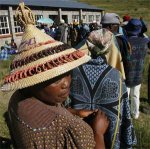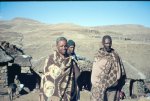Lesotho Its people, issues and history

About Lesotho
Lesotho (pronounced li-soo-too), is officially the Kingdom of Lesotho, a landlocked country entirely surrounded by the Republic of South Africa which covers an area of 30 000 square km – roughly the size of Belgium or the US state of Maryland. Formerly Basutoland, the name Lesotho translates roughly into "the land of the people who speak Sotho". Lesotho is also known as the Kingdom in the Sky as the entire country lies 1000m above sea level and includes Thabana-Ntlenyana, which at 3482m is the highest peak in Africa south of Kilimanjaro. The twin spines of the Drakensberg and Maluti mountain highlands dominate Lesotho’s formidable terrain and occupy three-quarters of the country’s area giving sanctuary to a unique developing nation. The country offers an opportunity to experience Africa's natural beauty and the simplicity and warmth of the friendly Basotho people who have developed a rich culture within their towns and isolated villages.
Current issues


The Basotho people (the local inhabitants of Lesotho) are renowned for their crafts, and their traditional products have a reputation for quality, individuality and variety. For many years ponies were their only means of transport through the mountainous terrain, resulting in a strong tradition of horse-riding and breeding.
The traditional Basotho Hat, or mokorotlo, is the best known of a fine range of grass-works made in Lesotho. It's conical shape is seen everywhere in the kingdom, and is the recognized symbol of the country. The hat’s shape is believed to have been inspired by the Qiloane mountain near the mountain fortress of Moshoeshoe I - Thaba-Bosiu.

The flag
The flag of Lesotho features a prominent black 'mokorotlo' or Basotho hat at its centre. The upper blue band signifies sky and rain, the middle white band peace and the lower green band the land of Lesotho.

The traditional Lesotho house is called a mokhoro and being built in the rondavel style is usually round and made with local materials. The walls will often be constructed from stones held together with a mortar of sand and soil mixed with dung. The floor is finished with a tamped dung mixture to make it smooth. The roof is thatched, a process that can take as little as one weekend or up to a year when made by a skilled artisan who will sewn in one section at a time, starting from the bottom working towards the top. As each section is sewn, it may be weathered and aged in so as to form a complete weatherproof seal.
History of Lesotho
The rise of the Basotho
The Basotho people have lived in southern Africa since around the fifteenth century whereas the modern Basotho nation of Lesotho emerged during the early 1800s under the leadership of King Moshoeshoe I who gathered together different clans of Sotho-Tswana people that were dispersed across southern Africa. King Moshoeshoe I is considered the father of Lesotho’s history. He began his rise to prominence as a local chief of a small village. Around 1820 he led his villagers to Butha-Buthe, a mountain stronghold, where they survived the first battles of the Mfecane (Difaqane, or Lifaqane in the Sesotho language) an African expression meaning "the crushing" or "scattering" and exemplifies a period of widespread chaos and disturbance in southern Africa during the period between 1815 and about 1840 when Zulu chieftain Shaka created a militaristic and expansive Zulu kingdom. In 1824 Moshoeshoe moved his people to Thaba-Bosiu, a mountaintop that was even easier to defend. King Moshoeshoe I rose in diplomatic status with his acts of friendship towards his beaten enemies. He provided land and protection to various Sotho peoples and this strengthened the growing Basotho nation. His influence and followers grew from an inflow of refugees and victims of the continuing Mfecane.
The nation of Lesotho
By the later part of the 1800s, King Moshoeshoe established the nation of the Basotho or Basutoland. Around the 1830s Europeans (mainly Afrikaners) started to migrate as settlers into the centre of South Africa and continued the on-going conflict between Europeans and Africans. In an attempt to be prepared for any such conflict in Basutoland, Moshoeshoe asked missionaries to come and live among his people. He believed that in this way he could buffer his country against the encroaching Europeans and other African groups.
ALLIANCE WITH THE CAPE COLONY
For strategic reasons and mainly for protection against the Voortrekkers (today’s Afrikaners), in 1843 the Basotho became allies with the British Cape Colony. During the period that followed many wars and conflicts took place between the Basotho, the Afrikaners and British. This happened at the backdrop of increased colonisation in Africa by Britain and shifts in possession of the Free State region between the Afrikaners and the British.
ANNEXATION AND INDEPENDENCE
Eventually the British annexed Basutoland in 1868 and finally Basutoland gained its independence and became the Kingdom of Lesotho in 1966.
Today, although the Lesotho Government is a constitutional monarchy, it is the Prime Minister who is head of government and has executive authority. The king now serves a largely ceremonial function and is prohibited from actively participating in political initiatives. Letsie III is the current king of Lesotho. He succeeded his father, Moshoeshoe II in 1996..
Why is Lesotho surrounded by South Africa?
Lesotho’s sovereignty came about almost fortuitously as Basutoland was, at the time of South African unification, a British Protectorate and was not included into the Union of South Africa.






